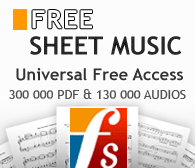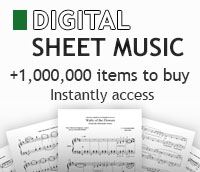Bach, Johann Sebastian - Aria: "Lasset dem Höchsten ein Danklied erschallen" for Bassoon & Strings BWV 66 No 3 String quartet, Flute and Basson |
| Composer : | Bach, Johann Sebastian (1685 - 1750) | ||||
| Instrumentation : | String quartet, Flute and Basson | ||||
| Style : | Baroque | ||||
| Arranger : | MAGATAGAN, MICHAEL (1960 - ) | ||||
| Publisher : | MAGATAGAN, MICHAEL | ||||
| Copyright : | Public Domain | ||||
| Added by magataganm, 21 Jul 2015 Erfreut euch, ihr Herzen (Rejoice, you hearts), BWV 66, is a church cantata for Easter by Johann Sebastian Bach. The cantata is Bach's first composition for Easter in Leipzig. The day before, on Easter Sunday of 1724, he had performed Christ lag in Todes Banden, BWV 4. He derived the cantata for the Second Day of Easter ("den zweiten Osterfesttag") from his earlier secular work, the Serenata Der Himmel dacht auf Anhalts Ruhm und Glück composed in Köthen. On the Third Day of Easter of 1724 he performed Ein Herz, das seinen Jesum lebend weiß, BWV 134, which he derived in a similar way from Die Zeit, die Tag und Jahre macht, BWV 134a, a cantata to celebrate the New Year's Day of 1719 in Köthen. Bach performed the cantata again in Leipzig on 26 March 1731 and probably on 11 April 1735. The exuberant first movement was derived from the final movement of the secular cantata. It opens with a virtuoso orchestral introduction of 24 measures, depicting vital joy. First the alto shouts: "Erfreut, ihr Herzen" (Rejoice, you hearts), the tenor continues "Entweichet, ihr Schmerzen" (fade away, you sorrows), all voices proclaim in homophony: "Es lebet der Heiland und herrschet in euch" (the Savior lives and rules within you). The middle section is given mostly to alto and tenor, who illustrate mourning and fear in a sorrowful "series of poignant descending chromatic passages and suspensions", although the words speak of the chasing away these moods: "Ihr könnet verjagen das Trauren, das Fürchten, das ängstliche Zagen" (You can drive away mourning, fear, anxious despair). The continuo plays repeated "trembling" notes, a "heartbeat" as Bach used later in the tenor recitative of his St Matthew Passion, "O Schmerz! Hier zittert das gequälte Herz" (O pain! Here trembleth the tormented heart). Finally the choir enters, one voice after the other building a chord, gently adding words of consolation: "Der Heiland erquicket sein geistliches Reich" (the Savior revives his spiritual kingdom). The instruments throw in motifs of the introduction, leading to the recapitulation of the first section. The movement has been termed "one of the longest and most exhilarating of Bach’s early works". After a short recitative the bass continues with a general request to thank God in song, in an aria in dancing motion. The middle section juxtaposes a long note over six measures on "Frieden" (peace) and coloraturas on "leben" (live). Movement four is begun by the tenor (Hope), who also wants to sing of victory and thanks ("ein Sieg- und Danklied"). He starts it "Mein Auge sieht den Heiland auferweckt" (My eye beholds the Savior reawakened), with a long melisma showing the reawakening. But already after one measure the alto (Fear) imitates the phrase on the words "Kein Auge sieht ..." (No eye beholds ...). After singing together extendedly, the two different viewpoints are rendered in an argument, termed "a linear discourse as in conventional conversation", ended by the alto trying to believe: "Ich glaube, aber hilf mir Schwachen" (I believe, but help my weakness). In the following duet the voices are homophonic for most of the time, but with little rhythmical differences, showing their different attitude to the darkness of the grave (des Grabes Finsternissen): the alto expresses "ich furchte zwar" (I truly fear) on steady long notes, whereas the tenor tells in ornamented figuration "ich furchte nicht" (I do not fear). In the continuation they also deviate only on one word, "klagete" (lamented) in the alto, "hoffete" (hoped) in the tenor. The flowing 12/8 time signature of the duet and a virtuoso solo violin are reminiscent of the original purpose of the music in the congratulatory cantata. It is most fitting for the middle section of the da capo form, when both voices agree: "Nun ist mein Herze voller Trost" (Now my heart is full of comfort). The cantata is closed by the second part of the hymn Christ ist erstanden, starting with a threefold Alleluja. It was derived in the 12th century from the Easter sequence Victimae paschali laudes, originally codified by Wipo of Burgundy around 1040. The verses underwent a substantial transformation by Martin Luther with the help of Johann Walter and were printed by Joseph Klug, Wittenberg, 1533. This is the only use by Bach of Christ ist erstanden in a vocal work, but he uses the related hymn "Christ lag in Todesbanden" elsewhere (in the cantata of the same name and Der Friede sei mit dir, BWV 158). The cantata in six movements is festively scored for alto, tenor, and bass soloists, a four-part choir, trumpet, two oboes, two violins, viola and basso continuo including bassoon. Source: Wikipedia (https://en.wikipedia.org/wiki/Erfreut_euch,_ihr_Herzen ,_BWV_66). I created this arrangement of the first Aria: "Lasset dem Höchsten ein Danklied erschallen" (Let a song of thanks ring forth to the Highest) for Bassoon & Strings (2 Violins, Viola & Cello). Sheet central : | Erfreut euch, ihr Herzen (4 sheet music) | | |||






